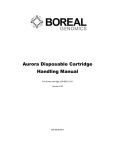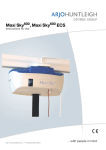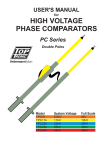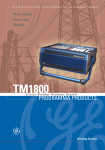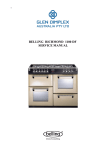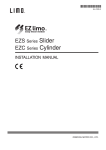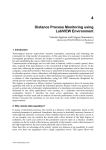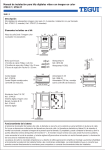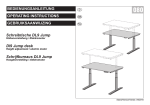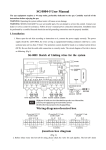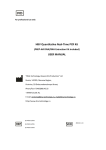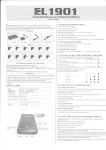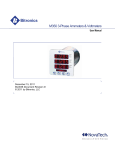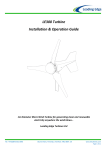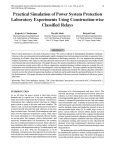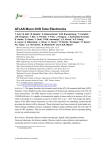Download N11-4 Ageing Test of ATLAS RPCs at CERN`s Gamma
Transcript
Ageing Test of ATLAS RPCs at CERN’s Gamma Irradiation Facility G. Aiellia , M. Alviggib , V. Ammosovd , M. Biancoc M. Bigliettib , P. Camarria , V. Canaleb , M. Capriob , R. Cardarellia , G. Carlinob , G. Chiodinic , F. Conventib , R. de Asmundis b , M. Della Pietrab , D. Della Volpeb , A. Di Ciaccioa , A. Di Simonea,1 , E. Gorinic , F. Grancagnoloc , P. Iengob , B. Libertia , A. Nisatie , Fr. Pastoree , S. Patricellib , R. Perrinoc , M. Primaverac , R. Santonicoa , G. Sekhniaidzeb , E. Solfarolia , S. Spagnoloc , Yu. Sviridovd , R. Varie , S. Venezianoe , V. Zaetsd . a b University of Rome ”Tor Vergata” and INFN Sezione di Roma II University of Naples ”Federico II” and INFN Sezione di Napoli d IHEP, Protvino c University of Lecce and INFN Sezione di Lecce e INFN Sezione di Roma I Abstract— An ageing test of three ATLAS production RPC stations is in progress at X5 GIF, the CERN irradiation facility. The chamber efficiency as a function of the operating voltage is measured at different source intensities, up to a maximum counting rate of about 700 Hz/cm2 . All along the test, plate resistivity has been monitored using two different methods: by measuring the I-V characteristics in pure Ar, and by comparing the efficiency vs high voltage curves at different source intensities. The increase in plate resistivity, which is one of the dominant ageing effects for RPCs with phenolic-melaminic electrodes, has been shown to be strongly dependent on environmental relative humidity. Indeed, after setting to values between 40% and 50% the relative humidity of both the operating gas and the air surrounding the chambers, a significant decrease of the plate resistivity has been observed. I. I NTRODUCTION The accelerator background at LHC will be dominated by soft neutrons and gammas that are generated by interactions of beam protons at very small angle [2]. Such a heavy background calls for severe requirements on the trigger detector in terms of rate capability and time resolution, which is crucial for bunch crossing identification. Moreover, for almost all the chambers installed in the ATLAS cavern, it will be impossible to perform any hardware reparation or substitution once the commissioning of the detector is terminated. It is therefore crucial that the chambers do not show any abnormal ageing effect which could degrade their performace during the ∼10 years of the ATLAS operation. For this reason an ageing test of three production ATLAS RPCs is being performed at CERN. The chambers are irradiated with γ rays in order to test their rate capability and to integrate the total charge of 0.3C/cm2 corresponding to ∼ 10 ATLAS years at the rate of 100Hz/cm2 which includes a safety factor of 5. 1 Corresponding author. [email protected] Tel. +39 062023644. E-mail: An- Fig. 1. Experimental setup at X5/GIF, with the trigger configuration used for cosmic rays runs. II. E XPERIMENTAL SETUP The Gamma Irradiation Facility, GIF, located downstream of the final dump of the X5 beam, uses a 137 Cs source of 20Ci to produce a large flux of 660 keV γ rays. A system of lead filters allows to reduce the flux up to a factor of 104 . The X5 muon beam can also be sent into the area. A more detailed description of this facility and of the characteristics of the γ flux can be found in [1]. Three production ATLAS RPC chambers (type BML-D, with gas volumes of 1.4m2 ) are installed in the GIF area, along the beam line. A schematical view of the setup is shown in figure 1. The chambers have 2 0-7803-8701-5/04/$20.00 (C) 2004 IEEE detector layers which are read out by strips oriented in both the η and ϕ directions. The chambers are perpendicular to the X5 beam line, with the long side (about 4m) oriented in the vertical direction. For details on the chamber structure, see [3]. The trigger is provided by the coincidence of three scintillator layers of 33x40 cm2 , each made of a three slabs hodoscope. During the beam runs, the three layers are aligned along the beam line, while for the cosmic rays runs, they are arranged as a telescope with the axis oriented at 40 degrees with respect to the vertical direction, in order to maximize the trigger rate. Signals from the frontend electronics are sent to a standard ATLAS “splitter board” [4] as in the final architecture foreseen for the trigger and readout electronics, and subsequently to TDCs working in common stop mode (see [5]) which record up to 16 hits per event per channel, in a 2µs gate. Both the leading and falling edges of the signals are recorded. The data acquisition is performed using a LabViewTM application. The DCS system, monitors both the low and and high voltages as well as the gap currents. The chambers are operated with the standard ATLAS gas mixture C2 H2 F4 /i–C4 H10 /SF6 = 94.7/5/0.3. Gas composition, together with all relevant environmental data such as pressure, temperature and relative humidity are controlled as well. The gas relative humidity, also monitored by the DCS, is set in the range of 30%-50% by bubbling in water a fraction of the total gas flow. In July 2003 the gas closed loop was introduced on 4 out of the 6 tested gas gaps, in order to simulate the real working conditions in ATLAS. The output gas of the chambers goes through a system of filters and then is sent again in the gaps, together with a fraction of fresh gas. The two remaining gaps were left in open flow for comparison. The total gas flow was set at 40 l/h, and the fraction of recirculated gas has been gradually increased up to 95%. Gas samples were taken at the input and output of the chambers and analyzed in order to find any polluting component related to the chamber operation. III. C HAMBER PERFORMANCE During the test, the chamber efficiencies are periodically monitored using cosmic rays triggered by the scintillators. Higher statistics efficiency measurements are made whenever the X5 muon beam is available. For each event, the muon trajectory is reconstructed. The scintillator slabs of the trigger system, of size 11x40cm2 , would only allow a very modest tracking. The tracking capability is therefore improved using the hits recorded by the RPCs, as described below: 1) hits recorded by the RPC under test are ignored in the tracking. 2) only hits registered in a time window of 25ns around the beam peak are considered useful for the track reconstruction, in order to reduce the probability to use an accidental photon hit in the tracking. 3) for each electronic channel (i.e. for each strip) a dead time of 50ns is applied by the analysis algorithm, in order to avoid any double counting due, for example, to after pulses. 4) tracks are reconstructed only for events showing a single cluster in at least three layers (out of the five available). This is useful to improve the quality of the reconstructed track eliminating, for example, di-muon events. 5) a track in both the η and ϕ directions is required. 6) the layer is considered efficient if it shows a cluster aligned to the track within ±1 strip. The steps described above are repeated for each gas gap. Single counting rates and average cluster sizes are also measured for each layer. Chamber efficiencies at closed source, measured periodically both with cosmic rays and with the X5 beam, did not show any loss along the test. Figure 2 shows the efficiency vs HV plots for Station 1 gap 1 ϕ at different source intensities. The high current driven by the gaps under source irradiation causes a voltage drop across the plates. Due to this drop, the plateaus show a shift towards higher voltages and a slower raise, compared with the plateaus taken without irradiation. This effect is enhanced in winter by low operating temperatures (10÷15 C) which increase the plate resistivity. IV. AGEING EFFECTS IN R ESISTIVE P LATE C HAMBERS Long time operation of resistive plate chambers is known (see for example [10]) to produce two main ageing effects, which degrade the detector performance: • changes in the chemical composition of the plates may increase their resistivity, thus reducing the rate capability. • the quality of the inner surface of the plates is degraded by continuous operation with fluoride-rich gas mixtures, leading to an increase of the noise in the detector. Both effects have been extensively studied during this test, and appropriate techniques have been introduced to reduce to an acceptable level all the losses in performace related to the detector ageing. A. Plate resistivity evolution It has long been known [6] that the electrical properties of the plastic laminate depend on the environment temperature and relative humidity. Materials such as phenolic-melaminic laminates have a negative temperature coefficient, i.e their resistivity decreases for increasing temperature. Moreover, when the plates are exposed to dry air circulation, their resistivity gradually increases even by a large factor. This effect is completely reversible once the sample is left at room RH for a sufficient time. On the other hand, plates kept under high current densities (hundreds of µA/m2 ) for long periods, also show a gradual increase in resistivity which is found to be faster when the plates are operated at lower RH values. This effect of the relative humidity has been shown [8] to be selective, in the sense that its effect is much more effective if the humidification is performed on the anode side of each plate. These observations suggest that both the gas mixture and the external environment need to be humidified in order to guarantee that the anodes of the two electrode plates are operated in the proper RH conditions. To achieve the necessary control on the external relative humidity, the area surrounding 0-7803-8701-5/04/$20.00 (C) 2004 IEEE efficiency Gap 1 - ϕ 500 450 1 400 0.8 Gap current (uA) 350 0.6 no source 0.4 0.2 gap 1 300 gap 2 gap 3 250 gap 4 gap 5 200 gap 6 a.f. 2 150 full source 100 50 0 8.5 9 9.5 10 10.5 HV (kV) 0 0 500 1000 1500 2000 2500 3000 Standard voltage (V) Fig. 2. Efficiency versus high voltage at different source intensities, as measured with the muon X5 beam.The plot refers to Station 1, gap 1, ϕ, after 5 ATLAS years of ageing. Fig. 3. I-V characteristics in pure Argon. Resistivity evolution gap 1 Argon gap 2 Argon gap 3 Argon gap 4 Argon gap 5 Argon gap 6 Argon Gap1 eff. plateau Gap2 eff. plateau Gap3 eff. plateau Gap4 eff. plateau Gap5 eff. plateau Gap6 eff. plateau mC/cm^2 RH fresh gas 200 350 300 150 250 200 100 150 100 50 Integrated Charge (mC/cm^2) RH 400 ρ (G Ω cm) @ 20 °C the three chambers under test has been delimited using PET foils. The air relative humidity near the chambers is hence controlled by means of two humidifiers. Two different methods were followed for the resistivity measurements: HV drop correction. This method is based on the comparison of the efficiency plateaus with and without source irradiation. The current driven under irradiation is much higher than the one just due to the muon beam or cosmic rays. This current produces a significant voltage drop across the plates and the voltage applied to the gas can be written (see [7]) as 50 0 0 11/10/2002 19/01/2003 29/04/2003 07/08/2003 15/11/2003 23/02/2004 02/06/2004 10/09/2004 Vgas = V − Rpl Igap (1) where Vgas is the effective voltage on the gas gap, V is the power supply voltage and I is the current driven by the gap. This drop causes the efficiency plateaus under irradiation to be shifted at higher HV values, as shown in figure 2. This shift, allows to evaluate the plate resistivity when the gap current is also measured. I-V characterstic in pure Argon. The standard ATLAS gas mixture is replaced by pure Ar. As shown in figure 3, the I-V curve is characterized in this case by a transition region around V=2 kV with a fast current increase. For higher voltages a linear current increase is observed. We assume that above the transition voltage, the drop across the Argon remains constant, so that the slope ∆V /∆I in the linear region gives the plates total resistance. Figure 4 shows the evolution of the plate resistivity as a function of time for the six gaps under test. The relative humidity of the gas mixture is shown as well. Starting from October 2003 both the inner gas and the environment surrounding the chambers were put under a constant 50% RH value. The resulting decrease in resistivity is clearly visible in the plot. This effect was shown to be reversible: a second period without humidification of the external air has produced again an increase in the plate resistivity. Fig. 4. Plate resistivity evolution. The controlled environment RH period is marked, together with the gas RH all along the test. B. Surface damage and noise level monitoring The gap current, defined as the total current driven by the gas as read on a resistance put on the ground connection of the gap, is continuously monitored by the DCS system. It is a reliable estimator of the number of avalanches in the gap and therefore of the noise level, when measured at low irradiation. Gap current measurements as a function of the operating voltage where taken almost daily all along the test, pointing out two main causes for the increase of the noise in the detector: • temperature increases have shown to be responsible for increases in the gap currents (at working point); • any malfunctioning of the gas system, such as insufficient total flow or lack of maintenance of the recirculation system’s filters, had a serious impact on the gas gaps, causing a rapid increase of the gap currents. Figure 5 shows the variation of the working currents of the six gaps along the test as well as the operating temperature. Current measurements are taken at closed source. It is clear the correlation between temperature and current variations, in particular for Station1, gap2 (gap 2 in the plot). The current 0-7803-8701-5/04/$20.00 (C) 2004 IEEE Working current evolution gap 1 open flow gap 5 closed loop gap 2 open flow gap 6 closed loop 1 volume/2 h gap 3 closed loop T V. DAMAGE RECOVERY 50% external RH 35 30 Wrong mixture Filter exausted 25 25 20 20 15 15 10 10 5 0 Temperature (°C) 30 21/10/02 5 29/1/03 9/5/03 17/8/03 25/11/03 4/3/04 Fig. 5. Working current evolution. Gap numeration is given here starting from the nearest to the source (gap 1) to the farthest (gap 6). The gas flow (in volumes per hour) is reported, together with the start of the recirculation test. External RH control is indicated as well. Ohmic current evolution gap 1 open flow gap 2 open flow gap 3 closed loop gap 5 closed loop gap 6 closed loop T gap 4 closed loop recirculation stop 0.7 30 0.6 25 0.4 20 0.3 15 0.2 Temperature (°C) Current (micro A) 0.5 10 0.1 0 21/10/02 5 29/01/03 recirculation stop with no major effects on the working currents lead indeed to a high increase in the ohmic currents. 1 volume/0.5 h (recirculation) 40 Current (micro A) gap 4 closed loop 09/05/03 17/08/03 25/11/03 04/03/04 Fig. 6. Ohmic current evolution. Gap numeration is given here starting from the nearest to the source (gap 1) to the farthest (gap 6). increase, which is amplified in summer, is however completely reversible, as shown in the plot. Working currents have also proven to be an effective tool to detect any malfunctioning of the gas recirculation system. The two arrows in figure 5 point out peaks of current due to two of such events: the first is due to a wrong gas mixture and the second one to the exhaustion of one of the filters of the recirculation system. In addition to working current, a useful parameter for the diagnostics of the plate surface status is the measurement of ohmic current, defined as the gap current at low voltage, where no gas multiplication is possible. Ohmic currents are only due to conduction through the internal surface and can therefore indicate the presence of pollutants on the plate surface before any actual damage of the surface can occur. The typical HV range for ohmic currents measurements is 5÷7kV . Figure 6 shows the evolution of the ohmic currents for the gaps under study. A comparison with figure 5 clearly shows that ohmic currents have very small absolute values but show larger relative increases as a consequence of gas problems. For example, the effect of filter exhaustion is much bigger on the ohmic currents than on the working currents. Wrong gas mixture didn’t have any influence on the ohmic currents, as expected, while a The X5/GIF test was also an important benchmark for testing suitable techniques of damage recovery. The most significant case of recovery followed an accident in which, after an integrated charge corresponding to about 7 ATLAS years (with a safety factor of 5), a malfunctioning of the recirculation system caused the suspension of the gas flow while a problem with the DCS system prevented the HV to be turned off. The result was a three days operation period under full irradiation with no gas flow. As a consequence, the chambers showed a very high increase in both ohmic and working currents which prevented the chambers from reaching full efficiency under full irradiation. At closed source, however, chamber performace was still satisfactory. The recovery procedure consisted in the following steps: • the chambers were fluxed with pure Argon at 3 volumes/hour for about five weeks, and a sensitive decrease of the gap currents was observed. Nevertheless, the noise level at working point was still too high to allow efficient operation of the chambers under full irradiation, being still ohmic and working currents greater than their normal values by a factor 3. • for the following two months the chambers were fluxed with an isobutane enriched mixture (C2 H2 F4 /i–C4 H10 /SF6 = 84.7/15/0.3), keeping their HV at a low value (7kV ). The decision to increase the isobutane concentration is based on the observation, made in previous tests, about the strong effect of isobutane in recovering a damaged plate surface. Indeed, during the operation with the new mixture both ohmic and working currents returned to their normal values, as shown in figure 7, where the values of the currents are plotted as a function of time. For clarity, only the measurements taken at the same temperature are shown. VI. C ONCLUSION The measurements performed at X5-GIF on three ATLAS production RPCs provided important information on the ageing effects of the gas gaps. As known from previous tests [10], the plate resistivity increased significantly at the beginning of the test, mainly due to the dry environment. Once the relative humidity of the experimental area has been put under control and set around ∼50%, the resistivity showed a significant decrease. The performance of all tested chambers remains much above the ATLAS requirements. Indeed, after an integrated charge corresponding to 7 ATLAS years (including a safety factor of 5) all the gaps under test showed a very good detection efficiency even at fully opened source, with a counting rate of about 600Hz/cm2 . Both ohmic and closed source working currents were used to monitor the quality of the internal plate surface. Any problem related to the gas system has shown to generate an increase on both currents. In particular, the increase on the ohmic currents 0-7803-8701-5/04/$20.00 (C) 2004 IEEE 25 1 0.8 23 20 21 15% isobutane gap 1 Serie1 gap 2 Serie2 gap 3 Serie3 gap 4 Serie4 Serie5 gap 5 Serie6 gap 6 TSerie7 25 I (uA) 30 1.2 27 T (°C) 35 I (uA) 15% isobutane Serie1 gap 1 Serie2 gap 2 Serie3 gap 3 Serie4 gap 4 Serie5 gap 5 Serie6 gap 6 Serie7 T 27 25 23 0.6 21 T (°C) 40 15 10 19 Working currents 17 5 0 13/02/2004 15 03/04/2004 23/05/2004 12/07/2004 31/08/2004 0.4 0.2 19 Ohmic currents 17 0 13/02/2004 15 03/04/2004 23/05/2004 12/07/2004 31/08/2004 Fig. 7. Gap current isotherms. The values of ohmic and gap current of the six gaps are plotted as a function of time. Only measurements taken at the same temperature are plotted. was shown to be a very early and safe indicator of gas poisoning. These increases were completely reversible, provided that the gas flow and composition are promptly restored to correct values. The present gas recirculation system has been proven to be (so far at the level of ∼4 ATLAS years of ageing) adequate to ATLAS, provided that the filters are properly maintained and changed when necessary. Damage recovery procedures such as Argon fluxing and low voltage operation with isobutane-enriched mixtures were successfully applied after a critical stop of the gas system which caused major damages to the internal plate surface. ATLAS RPCs have thus shown to be robust enough to tolerate extremely harmful events, on the condition that proper recovery techniques are applied. R EFERENCES [1] S. Agosteo et al., A facility for the test of large area muon chambers at high rate, CERN-EP-2000-031, February 16th, 2000. [2] A. Ferrari and P. Sala, ATLAS Internal Note, MUON-NO-162 (1997). [3] ATLAS Muon Collaboration, ATLAS Muon Spectrometer Technical Design Report, CERN/LHCC 97-22. [4] ATLAS Collaboration, ATLAS First-Level Trigger Technical Design Report, CERN/LHCC 97-22 (1998). [5] E. Gennari et al., 32 channel TDC VME board - User’s Manual, http://sunset.roma2.infn.it/tdc/tdcboard.ps. [6] R. Cardarelli et al., Avalanche and streamer mode operation of resistive plate chambers, NIM, Nuclear Instruments and Methods in physics research A382 (1996). [7] G. Aielli, Ph.D. thesis, University of Rome Tor Vergata, February 2001. [8] G. Aielli et al., Electrical conduction properties of phenolic-melaminic laminates, presented at the ”VII Workshop on Resistive Plate Chambers and related detectors”, Clermont-Ferrand, October 20-22, 2003. [9] G. Aielli et al., F− ions Production in RPC Operated with Fluorine Compound Gases, presented at NSS 2004, Rome October 16-22 2004. [10] G. Aielli et al., Performance of a large size RPC, equipped with the final ATLAS front-end electronics, at X5-GIF facility, NIM Nuclear Instruments and Methods in physiscs research A456 (2000) 77. 0-7803-8701-5/04/$20.00 (C) 2004 IEEE





